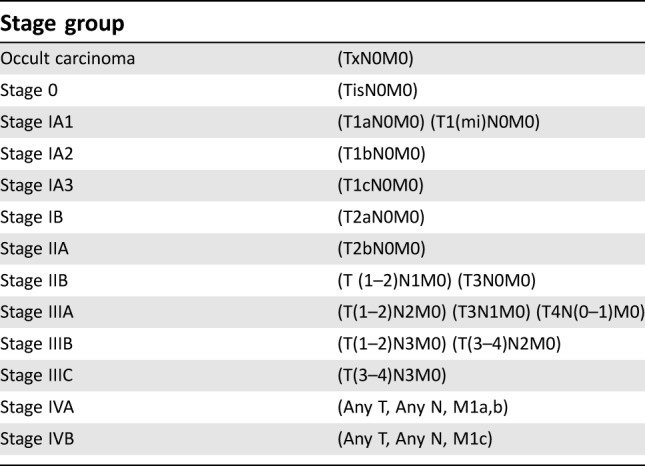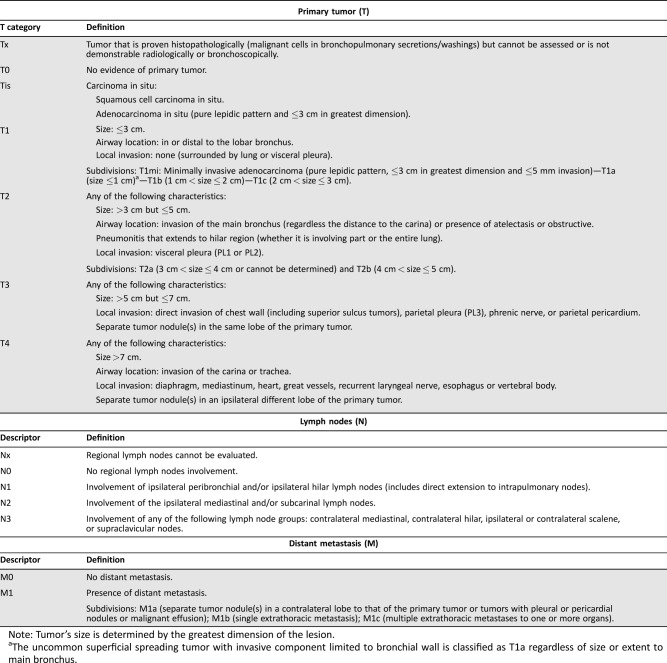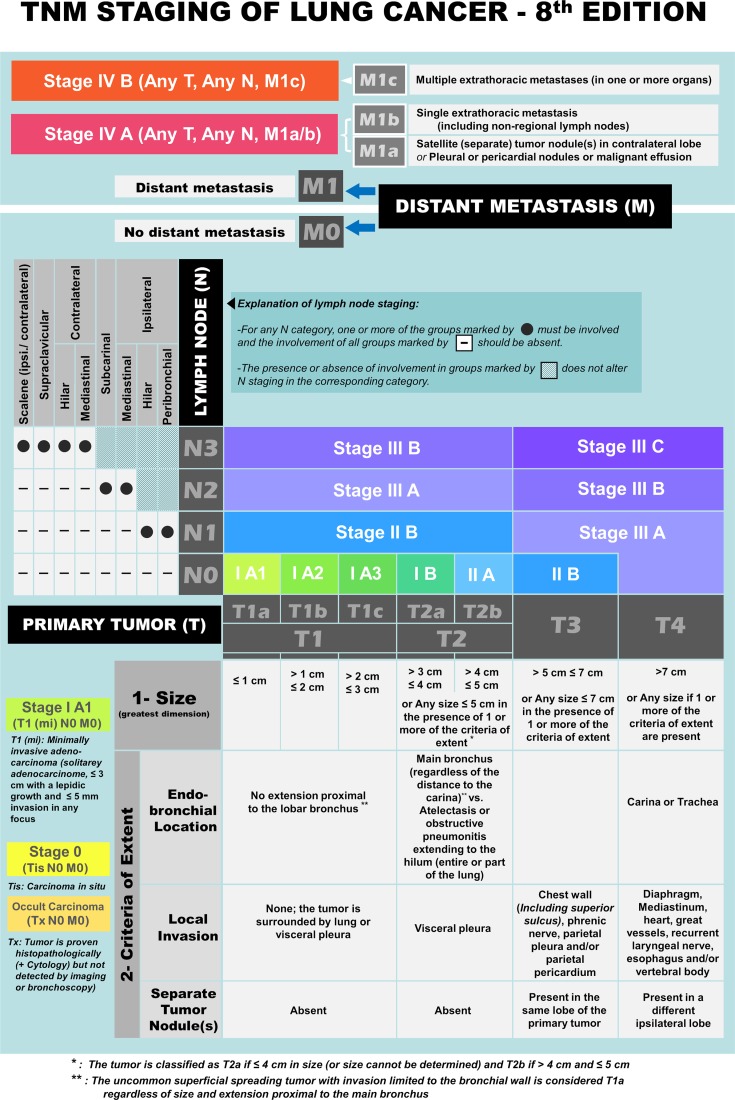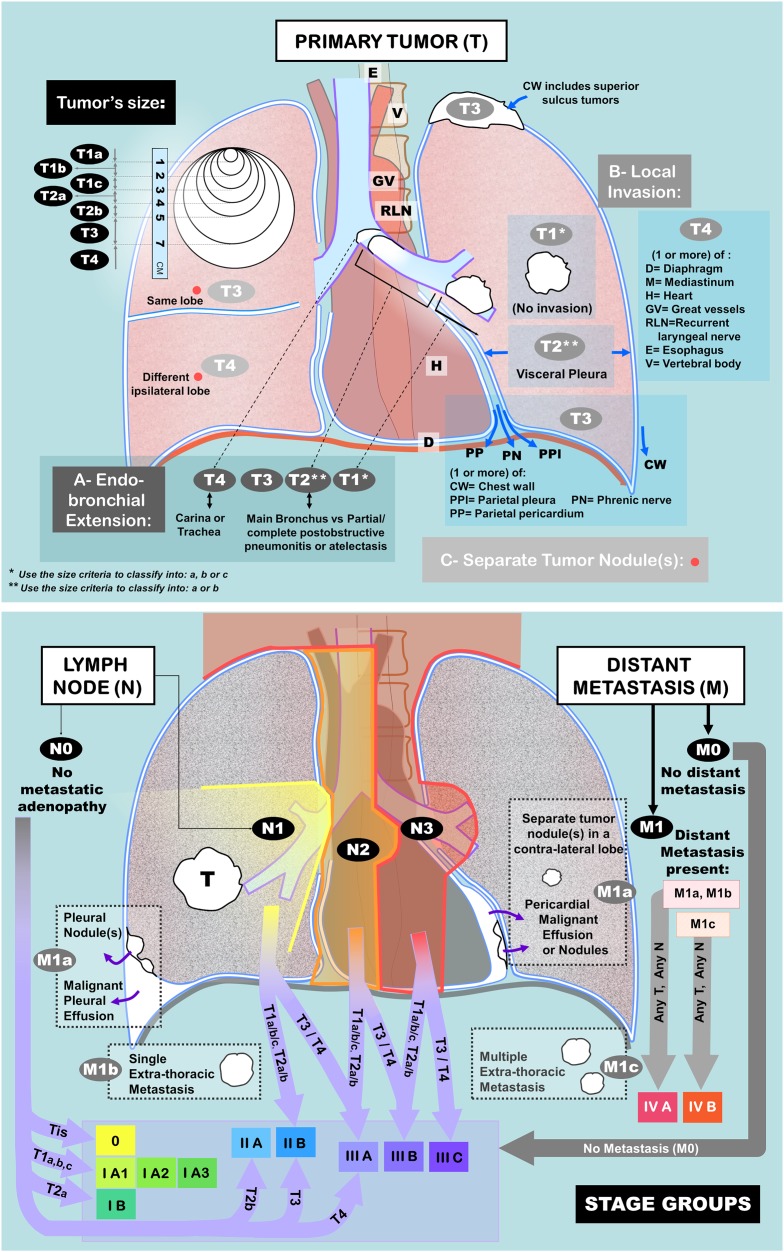This article presents the new TNM staging system for lung cancer in a concise, yet comprehensive, visual format.
Abstract
Lung cancer is the leading cause of cancer‐related mortality in the U.S. TNM staging of lung cancer is implemented to define the extent of disease and consequently assign prognosis and guide treatment. The newest edition of TNM staging of lung cancer has been released recently. In this article, we present the TNM staging of lung cancer in a concise, yet comprehensive, visual format.
Lung cancer is still estimated to be the most frequent cause of cancer‐related death in both men and women in the U.S. [1]. The anatomic extent of cancer is described by the TNM staging system. Such consistent reproducible classification is essential for predicting prognosis, selecting and optimizing treatment, and assessing response to treatment. Communication and clinical research are facilitated by using this uniform system. TNM staging has three components: the features/extent of the primary tumor (T), regional lymph node(s) involvement (N), and distant metastases (M). The eighth edition of TNM classification/staging for lung cancers has been recently introduced. The revisions in this edition were based on recommendation from analyses of databases of the International Association for the Study of Lung Cancer and were adopted by the American Joint Committee on Cancer and the Union for International Cancer Control [2], [3], [4].
The new TNM classification is summarized in Tables 1 and 2. The revisions in the eighth edition of the TNM staging include several changes in the T and M categories as well as in the stage grouping. These can be summarized as follows:
Table 1. Eighth edition of TNM staging of lung cancer: Definition of T, N and M.
Note: Tumor's size is determined by the greatest dimension of the lesion.
The uncommon superficial spreading tumor with invasive component limited to bronchial wall is classified as T1a regardless of size or extent to main bronchus.
Table 2. Eighth edition of TNM staging of lung cancer: Stage grouping.

Modifications of the primary tumor classification
Redefinition of T based on size by adding a new category (T1c) and subdividing T1 and T2 into T1a, T1b, T1c, T2a, and T2b (using 1 cm intervals from ≤1 cm to ≤5 cm. Additionally, the size definition for T3 is changed to >5 and ≤7 (from >7 cm previously). Tumors larger than 7 cm are now reclassified as T4.
Removal of the 2‐cm distance from the carina as a limit to separate T2 and T3 tumors with endobronchial extension into the main bronchus. Currently, these tumors are considered T2 (as long as the carina is not involved). Similarly, tumors with complete lung atelectasis or obstructive pneumonitis are considered as T2 rather than T3.
Elimination of the mediastinal pleura invasion from the criteria of T3 definition. Invasion of the diaphragm is currently a descriptor of T4 rather than T3.
Subdivision of carcinoma in situ into squamous cell carcinoma in situ and adenocarcinoma in situ.
Adding T1 mi (minimally invasive carcinoma) as a new T category.
Redefinition of metastases (M)
Revision of cases with distant metastasis (the previous M1b category) into M1b and M1c based on the number of the metastatic foci (single [M1b] versus multiple [M1c]).
Changes to stage groupings
Subdivision of stage IA into stages IA1, IA2, and IA3, which correspond to T1aN0M0, T1bN0M0, and T1cN0M0, respectively.
Reassignment of T1 and T2a nonmetastatic tumors with N1 lymph node involvement (T1[a–c]N1M0 and T2aN1M0) as stage IIB (from stage IIA in the previous seventh edition).
Reassignment of T3 nonmetastatic tumors with N2 lymph node involvement (T3N2M0) from stage IIIA to stage IIIB.
The newly defined stage IIIC includes nonmetastatic T3 and T4 tumors with N3 lymph node involvement (T3N3M0 and T4N3M0)
Tumors with M1a or M1b disease are currently grouped as stage IVA, and tumors with M1c disease are grouped as stage IVB (regardless of the T or N status).
In the new eighth edition of TNM staging, the regional lymph node (N) classifications and the unified map of lymph node stations remain unchanged from the prior edition.
We present a reference chart and diagrams that consolidate the eighth edition of the TNM staging system of lung cancer. The chart (Fig. 1) is separated into two frames based on the status of the distant metastatic involvement (M). The upper frame details the classification in the presence of metastases. In the lower frame, which is dedicated to tumors without distant metastases, comparative features of the primary tumor (T) are described in the vertical columns, and the regional lymph node involvement (N) is detailed in the horizontal columns. The (T) definition includes the tumor size and other criteria of extent, such as endobronchial location, local invasion, and separate tumor nodule(s). The intersection of the horizontal and vertical columns will define the corresponding stage group. Color coding is used to facilitate the visualization of the different stage groups. Stages with unique characteristics are defined separately. The diagrams (Fig. 2) demonstrate the TNM staging classification using more consolidated pictorial format (Fig. 2). The general design of the chart and the diagrams is based on our previously published work about the seventh edition of the TNM staging system [5]. The simplified, yet comprehensive, visual format can serve as an effective quick reference, given the increasing complexity of the TNM classification. Additionally, using such a format may facilitate learning, understanding, and memorizing of the staging system.
Figure 1.
Reference chart summarizing the eighth edition of TNM staging classification of lung cancer.
Figure 2.
Reference diagrams depicting the eighth edition of TNM staging classification of lung cancer. First, define T category by matching the greatest dimension and the appropriate T category. Second, upgrade the classification based on the other criteria of primary tumor invasion/extent if applicable (use the criteria of invasion/extent [endobronchial extension (A), local invasion (B), and separate tumor nodule(s)(C)] only to assign a higher, not lesser, T classification). Finally, use the lower diagram to assign N and M classifications then combine that with the T category to define the corresponding stage. In the lower illustration, N1, N2, N3, and the separate tumor nodule(s) of M1a were described based on right‐sided primary neoplasm (marked with letter T). Use a mirror image in the case of left‐sided lung neoplasm.
Footnotes
For Further Reading: Mariana Chavez‐MacGregor, Elizabeth A. Mittendorf, Christina A. Clarke et al. Incorporating Tumor Characteristics to the American Joint Committee on Cancer Breast Cancer Staging System. The Oncologist 2017;22:1292–1300; first published on June 7, 2017.
Implications for Practice: This study demonstrates that stage, but also breast cancer subtype and grade, define prognosis in a large population of breast cancer patients. It shows that a point‐based risk score system that incorporates these biological factors provides refined stratification and information on prognosis, improving the anatomic American Joint Committee on Cancer (AJCC) staging system. In addition, the overall mortality and breast cancer specific mortality rates detailed here provide much‐needed information about prognosis in the current era, refining the current AJCC staging.
Disclosures
The authors indicated no financial relationships.
References
- 1. Siegel RL, Miller KD, Jemal A. Cancer statistics, 2017. CA Cancer J Clin 2017;67:7–30. [DOI] [PubMed] [Google Scholar]
- 2.Rami‐Porta R, ed., Staging Manual in Thoracic Oncology, 2nd Edition. North Fort Myers, FL: Editorial Rx Press, 2016. [Google Scholar]
- 3.Amin MB, ed. AJCC Cancer Staging Manual, 8th Edition Switzerland: Springer, 2017:431–455. [Google Scholar]
- 4. Goldstraw P, Chansky K, Crowley J et al. The IASLC Lung Cancer Staging Project: Proposals for revision of the TNM stage groupings in the forthcoming (eighth) edition of the TNM Classification for Lung Cancer. J Thorac Oncol 2016;11:39–51. [DOI] [PubMed] [Google Scholar]
- 5. Lababede O, Meziane MA, Rice TW. Seventh edition of the cancer staging manual and stage grouping of lung cancer: Quick reference chart and diagrams. Chest 2011;139:183–189. [DOI] [PubMed] [Google Scholar]





